Abstract
This dissertation has intended to investigate the perception and attitude of tourists towards ICT implication in the heritage tourism of China by coordinating with the Chinese tourism industry, market trends of the heritage sector, and ICT Implementation in China’s Tourism Industry by taking into account customer’s motivation and attitude to the impact of ICT integration. With this intention, this dissertation has engaged to generate an improved understanding of the business application of ICT that would assist the Chinese heritage tour operators, marketers, and regulatory authorities to organize an enhanced strategy to develop heritage tourism in China coordinating with customers’ options.
Introduction
This Dissertation critically illustrates the perceptions and attitudes of tourists to the ICT implication in the practice of heritage tourism in China, the response of the tourism industry, and the factors affecting the motivation and exploration of e-tourism by the concurrent practice of online marketing and e-commerce that materialized and experienced in the global marketplace and simultaneously influenced the Chinese tourism Industry.
The quick-shifting improvement in the information communication technology and its cost-effective implication have dramatically changed the structure of business operation in every industry, while tourism is not away from this global trend. As an integral part of the global tourism industry, the heritage tourism sector of China has been implementing its fast growing ICT automation to explore its historical and cultural heritage in the global tourism market to attract overseas tourists and travelers. Although the heritage tourism sector of China has successfully implemented ICT, the heritage tourism management is under continuous pressure for the conservation of the heritage visitors attractions for the future generation and has been facing many dilemmas to preserving them.
This dissertation scrutinizes how the ICT adoption is gradually changing tourist’s motivation to the heritage tourism of China; how significant are these changes; what are the vital factors to generate tourists perception, do the tourists perception and attitude would contribute Chinese heritage management to explore its tourism products in the global market and at the same time to its conservation. Moreover, it is essential to scrutinize the regulatory framework related to heritage preservation and ICT implication in China and this study would be organized with six major chapters including concerned sub-chapters that would finally support to attain its conclusion by analyzing the background problem, exploration for literature review, along with appropriate research methodology in conjunction with result and findings.
Background of the problem
Ma, Buhalis & Song (2003) pointed out that the heritage attractions of China have gained major international focal during the eighties following the implication of CRS and GDSs by the CNTA, the commercialization of the Internet during 1995 has explored further opportunities for CNTA to explore its tourism sector to the rest of the world by implementing e-Tourism. Moreover, the commercialization of the Internet has brought radical changes in the tourism industry of China by introducing tourism principles, online marketing, presentation of heritage attractions on the web and social media, online booking ticket and direct selling connecting the intermediaries, suppliers, and consumers where the supply chain of tourism industry turned into more customers centric. The most prevalent dilemmas aroused from the intermediaries like travel and booking agents who fell in serious threat for abolishing their role in the industry while tourism service providers and service consumers would be able to meet together on the web and can transact securely without appearing to travel agents or traditional banking (Li & Suomi 2007; and Song & Cheung 2009).
By adopting e-Tourism application, the SMTEs kept their efforts to standardize their services through the Internet, Intranet, and Extranet that assisted to offer DMOs services, site promotion, pre, and post-tour information, but failed to represent any satisfactory framework of e-Commerce that would satisfy the interest of all stakeholders in this arena (Meladze & Jerenashvili 2010).
Buhalis & Jun (2011) presenting the global Internet users data of 2009 mentioned that its users reached 1.8 billion, which is 27% of the total world demography while several Internet users in China are 360.0 million, these statistics illustrate that uninterrupted enlargement of people for Internet penetration has robotically changed the ethics and characteristics of online communities. As a result, the Internet has turned into the most influential media where 84% of the modern travel plans are implemented based on the Internet information, communication, and also booking and payment, although the security measures and privacy are still questioned, thus, it’s essential for the heritage management authority of China to keep their more effort to overcome such dilemmas.
The China Daily (2013) reported that the Chinese tourism industry reached a new horizon of progress by adopting the Internet and introducing customized software named ‘Smart Travel’ for tour operators that facilitate the tourist’s different information of the World Heritage site including tour, traffic and booking from their mobile phone. This tourism-aided software connects with the mobile terminals and delivers all necessary data to the tourists and the tour operators get enhanced opportunity to innovate new tourism product in the market and drive to the smooth way of online marketing with less effort and small investment. The China Daily (2013) also added that to uphold the rising trend of the heritage tourism market, the FAB Enterprise Group of Beijing and Duty Group of Macao have signed a contract valued at US$ 102.7 million to establish mobile terminals that serve tourism data all over the country while the NTA has been formulating WiFi and 3-D technology for visitors.
CNN (2012) reported that although heritage tourism has gained a new shape by the implication of ICT, with 43 world heritage sites of China tourism industry has generated 2.6 billion trips to the sites and generate huge revenue, but such gigantic visitors make it quite difficult for heritage preservation. The incredible boom in the Chinese tourism industry has seriously threatened the conservation, preservation, and restoration actions of the UNESCO world heritage sites in the country; a large number of tourist buses, the crowd of visitors, sports car, entertainment rides, loudspeakers, photo snapping, food wastes, and careless behavior of the tourists continuously degrading the attractions. It is observed that the government policy has aimed to progressively more utilization of the world heritage sites as an economical vehicle to generate faster development of the backward areas where promoting tourism and gaining economic benefit is a major motivation rather than safeguarding the heritages.
As a result, the commercialization of the heritage sites and their surroundings are continuously increasing, local people are migrating by renting their homes from the core ancient cities due to growing visitors pressure that also seriously influenced the local culture. The local authorities have already doubled the admission ticket price to reduce the pressure of visitors but failed and it would boost the number of visitors at 16 million by 2015 while the monitoring mission of UNESCO in China and the conservation experts pointed to the failure of tourist management and governmental policy. To pressurize the Chinese government UNESCO has withdrawn the ‘World Heritage’ designation of two sites that could not keep any remarkable impact on the increasing tourist number while the government has some so-called ‘corrective measures’ and aimed to utilize the Global Heritage Fund to safeguard the sites. Such crisis of tourism management and governmental policies are required to sensible reform to rescue the Chinese tourism industry from long-term challenges where ICT could play a vital role to ensure sustainable development of heritage tourism in China.
Rationale of the research
Many heritage conservation experts and scholars have tried to find out the solution of the query that how the preservation of the heritage sites could bring economic prosperity and to what extent the tourism management could be able to bring a balance between the intangible inherent values of the heritage sites and tangible financial returns from them. Some of the concurrent researches addressed environmental issues related to the heritage sites and emphasized the conservation and protection with the aim to the prospect for future generation for learning and further study. Some previous studies pointed to the tourist’s attitude towards the heritage visitors’ attraction, implication of ICT in the tourism industry, customers’ trend towards the use of the Internet, but no remarkable research scheme has been anticipated yet on the perception and attitude of tourists towards ICT implication in the heritage tourism of China.
The rationale of this study is to analyze the consequence of ICT implication in the heritage tourism sector of China by investigating the real scenario of progress for ICT applications, e-Commerce integration, online marketing, ICT-vision of the country, conservation of the sites, heritage conservation policy, and the role of ICT to developing new heritage products to explore the global market. This paper would investigate the revolutionized contribution of the ICT implication in China tourism that facilitated the local economic and social development by influencing entertainment, education, governance, and economy pointing to the rich history and culture from the focal point of new technology adoption. Moreover, this research has aimed to boost the awareness of the Chinese policymakers and regulatory authorities to take into consideration of the heritage conservation for future generation rather than turning the heritage into tangible financial benefits by introducing the necessary legislative framework, where the investors and donor agencies like UNESCO would get greater confidence regarding corrective measures for heritage.
In addition, this thesis also aimed to enhance the cooperation between the Chinese academia, business, regulators, heritage authorities, policymakers, and tour operators with an improved understanding regarding manage and safeguard the world heritage sites in the country with the global standard by reducing existing practice where ICT would play the vital role in this regards. Although this study along with its result would contribute the Chinese heritage management authority, and heritage tourism companies to attain prospective inspiration to upgrade their current ICT implication model in China and gain a higher level of business confidence to develop new software for heritage site management that provides the companies greater competitive advantage in near future.
Research Question and Objectives
There is enormous research already conducted with the model of conservation and expansion of cultural heritage tourism in China, its historic development, Chinese views of nature and tourism, its attributes, concerned customer’s loyalty, and the adoption of the information technology in this sector, but no research topic has yet addressed to measure perception and attitude of tourists on ICT implication. The policymakers of China are enthusiastic to assess the competence of the heritage management to focus on the ideological agenda of cultural heritage policy linking with its legislative and economic context that would be proficient to bring a satisfactory return on the infrastructural investment and the knowledge management would contribute to the prospects of heritage (Svensson 2005; and Han 2006).
Although the government of China has identified the protection of cultural heritage as a significant responsibility, the practice demonstrates a very clear vision to generate tremendous revenue from heritage tourism and to boost its contribution to the national GDP growth (Lew 2003; Huibin, Marzuki & Razak, 2012). The objectives of the government strategy are extremely comprehensible that it supports both the tourism companies and the tourists with enhanced ICT facilities to explore its great heritage resources to the global tourism industry that would ultimately pick up the economic and business reality of China establishing its greater influence in the global marketplace where ICT is a supportive tool.
The global scenario of heritage tourism illustrated that the ICT has provided the most significant benefits of amplifying the supply of information of the world heritage sites, reduced cost of knowledge production and transformation and sharing, conquer the constraints of distance and border barrier that ultimately reduce the uncertainty associated with heritage tourism (Shanker 2008). China, as the most influential player in the global tourism industry, engaged itself to coup with the quick-shifting nature of e-commerce and online marketing with its richness of heritage resources and it is working to develop innovative heritage products that would turn the global tourism industry towards China as a focal point of next-generation e-Tourism.
This study would examine the appreciative knowledge in the field of heritage tourism and look to the emergence and development of the ICT implication in the Chinese tourism industry linking with its political economy, technological progress, recent market trends of tourism marketplace, associated skills of the human resource in China taking into account of the national ICT strategy of the country. From the point of view of the tourist’s perception and attitude to the ICT implication in Chinese heritage tourism, this study would investigate with subsequent research questions, the answer to these questions assist to gain smooth progress for heritage tourism by organizing new policy towards the greater motivation for the conservation of the heritage resources, the research questions are as below-
- To what extent the theoretical framework of ICT influence the tourism agencies to adopt advance ICTs
- To what extent Perception and attitude of the tourists have changed for IT integration
- What are the prospects and challenges of ICT implementation in the Heritage Tourism of China?
Relevant Literature Review
The purpose of this chapter is to focus on the theoretical framework of ICT and Heritage Tourism, perception and attitudes of the tourists after ICT implication in China, the tourism industry of China, ICT implication in the Heritage Tourism of China, importance, and challenges of ICT Implication in the tourism industry and so on.
The Conceptual Framework of ICT
Basic Definition of Information and Communication Technology
ICT comprises of technologies for instance all computers, software, peripherals, and the Internet line to accomplish information processing and communications activities; it also includes the groupware, Netware as well as the intellectual capacity to enlarge, program, and maintain tools (Freeman & Hasnaoui 2010; Buhalis & Law 2008; Doherty, Chadwick & Hart 2003; and Meier & Stormer 2009). UNESCO defined ICT as an amalgamation of informatics technology with other, connected technologies, particularly communication technology; at the same time, synergies arising from the application of these systems efficiently means that information is extensively available and accessible through different media and locations (Freeman & Hasnaoui 2010; Buhalis & Law 2008; Doherty, Chadwick & Hart 2003; and Meier & Stormer 2009).
Furthermore, individuals can employ mobile devices for instance laptop, mobile phone, digital television along with self-serviced terminals/kiosks to communicate and execute different tasks; however, this combination of ICT successfully incorporates different devices including hardware, software, groupware, and shapes the limitations between equipment and software (Buhalis & Jun 2011; Freeman & Hasnaoui 2010; El-Gohary 2010 and Buhalis & Law 2008).
Hardware is physical equipment for instance automatic, magnetic, electrical, or optical devices whereas software co-ordinates the task of hardware as pre-written detailed commands that control the function of a computer system; however, Netware is the combination of equipment and software to support networking system (Buhalis & Jun 2011; Buhalis 1998; Freeman & Hasnaoui 2010; El-Gohary 2010; and Alford & Clarke 2009). Groupware is communication tools that advance e-communication, for instance, e-mail, voice mail, fax, videoconferencing, and many others; on the other hand, humans have emphasized user competence and empowerment for technological development (Buhalis & Jun 2011; Freeman & Hasnaoui 2010; (Farsari & Prastacos 2004; Fedele 2012; Kanellopoulos, Panagopoulos & Psillakis 2004; El-Gohary 2010; Buhalis 1998; and Buhalis & Law 2008). Furthermore, telecommunication is the transmission of signals, images, and voices over long distances; however, these technologies include radio, television, telephony, satellite, wireless, and so on (Buhalis & Jun 2011; Buhalis & Law 2008; Freeman & Hasnaoui 2010; and Panagopoulos & Psillakis 2004).
Different Communication system
- World Wide Web: A multimedia protocol that uses the Internet (Buhalis & Jun 2011)
- Internet: it is a network to links multiple networks and users all over the world for which the Internet is part of ICTs (Brussee & Hekman 2010; Shinder 2010; Brookins 2013; and Toolkit 2011)
- Intranet: it is a corporate or government network to support all company data handling and processes (Hossain 2012, Brown 2010; Keller 2009; and Hassan & Bashir 2012)
- Extranet: it is a network, which uses the Internet to connect multiple intranets (Smits & Mogos 2012; Engel, Blackwell & Kollat 1995; and Stelzner 2011)
- E-commerce: E-commerce is a buying, selling, or exchanging goods, services, or information through computer networks and the Internet while (Buhalis & Jun 2011; Keller 2009; and Miller & Lammas 2010)
- E-tourism: The application of ICTs on the tourism industry (Hopken, Gretzel & Law 2009; Nuryanti 1996; and Pedersen 2002)
- Social media: it is the online platform and tools to share opinions and experiences (Sandilands 2013; Nurick 2000; Steinrücken 2010; and Smith & Chaffey 2005)
The Effectiveness of ICT in business
The literature of recent studies have identified that implementation of ICT has transformed the modern trading system as it indicates multiple communication technologies, for instance, SMS, Internet, Wireless, VOIP, GPS, GIS, and so on (Buhalis & Law 2008; Buhalis & Licata 2002; O’Connor & Murphy 2004; and Meier & Stormer 2009). In addition, progress in ICT had indisputably altered business environment, strategic goals, and company structures; the subsequent table analyzes the usefulness of ICT in business in more elaborately–
Table 1: Usefulness of ICT in business. Source: Self-generated.
ICT Strategy in China
Chen, Gao & Tan (2005) stated that the strategy of ICT in China has designed to use IT in the process of industrialization by taking advantage of a newcomer; however, the policymakers have introduced the Strategy of National Informatization 2006-2020 with the intent to boost the national economy and develop the lifestyle of the citizens. From the very beginning, the aim of IT adaptation was to develop the concept of informatization in all features of social and economic fields (Chen, Gao & Tan 2005; Xuesong 2006; and Li 2006). However, the strategic goal is to attain leapfrog in production within the next five years by using informatization as the engine for industrialization; at the same time, it needs to accelerate ICT infrastructure and services in the rural areas along with establishing State Council for Implementation of the Strategy (Xuesong 2006; Chen, Gao & Tan 2005; and Li 2006). However, China’s membership in WTO has created a new dimension in the telecommunication industry
Under this strategy, the administration emphasized more on the nationwide education and training on ICT from the school level for which the government allocated additional budget for the educational sector; moreover, the government intended to complete the construction of e-government infrastructure along with developing media and network information resources (Xuesong 2006; and Li 2006). At the same time, innovation of major information technology, low-cost internet access, and encourage e-commerce system in the large companies to develop logistical systems, productivity, electronic transaction process, and so on (Xuesong 2006; and Li 2006).
- Budget creation to training 300,000 to 400,000 university students to certify them; however, lack of English language skills and knowledge on international business make it difficult to achieve goals
- The government gives financial support to persuade firms to gain international certification, such as CMM/CMMI5 certification
- Moreover, MOFCOM will collaborate with the State Development Bank to give credit and loans to assist entrepreneurs
- According to the report of Li (2006), ICT strategy includes building a strong position in the international ICT market within the next 10 years and China will supply low-cost labor worldwide
Tourism Industry of China
Li & Suomi (2008, p.3) stated that the tourism sectors was one of the fastest-growing sectors in the national economy from the last two decades, which influenced the government to take different initiatives for future development, such as, provides three “Golden weeks” holidays to attract more tourists at this time. However, Li & Suomi (2008, p.3) further added that the tourism industry has arrived at US$1.90 billion (about 4.27% of the national GDP) in 2006; on the other hand, WTTC (2013) reported that China generated more than US$ 644 billion from the direct and indirect sources of travel and tourism segments. According to the report of WTTC (2013, p.2), China earned more profit from this industry rather than that of the automobile manufacturing, education, and communication services segments; in addition, the tourism industry helped gather more than 9.2% of China’s GDP in 2011; however, the following figures show the contribution of different industries in the national economy:
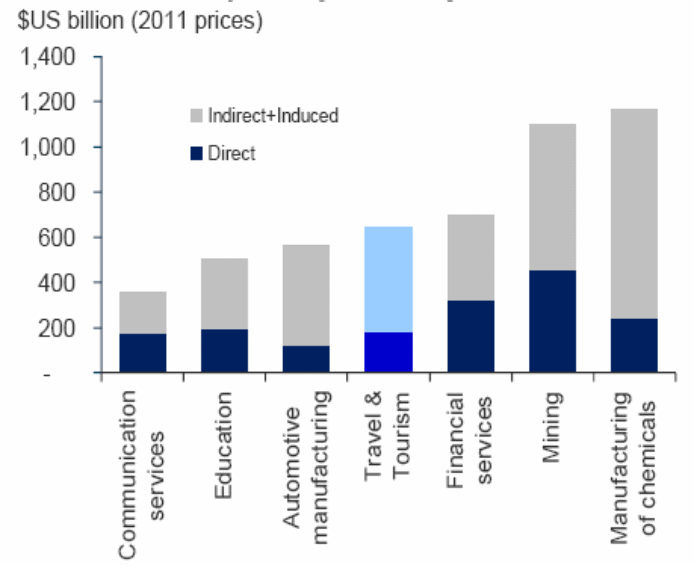
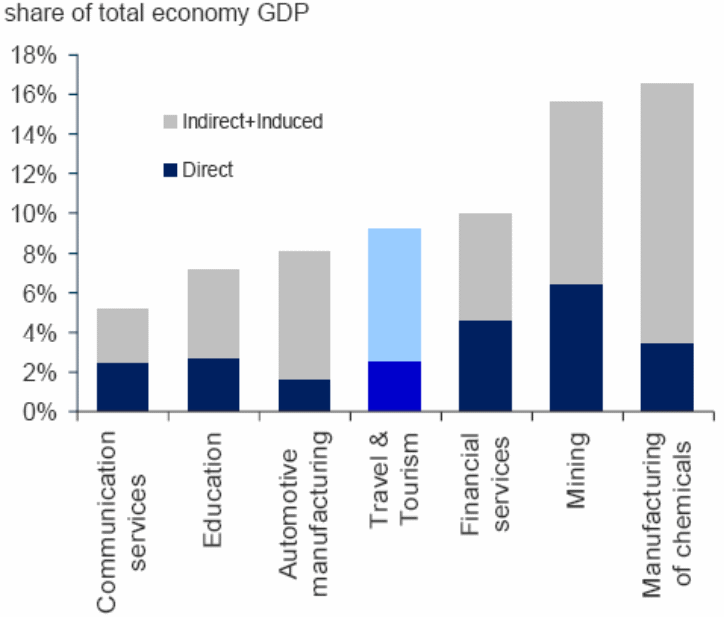
At the same time, WTTC (2013, p.4) stated that direct contribution to GDP from the Travel and Tourism industry increased by 430% from 1990 to 2011 whereas the total economy boosted by 693% over this15-year period; however, this industry is a major source of export revenue ($50,853 million or 2.4% total exports) for China. This industry has an enormous impact on the job market, such as this segment, directly and indirectly, created more than 61.90 million jobs (22,081 direct and 39,856 indirect jobs) or 8.10 percent of total employment of this country in 2011; however, the next figures demonstrate the contribution of different industries in the job market-
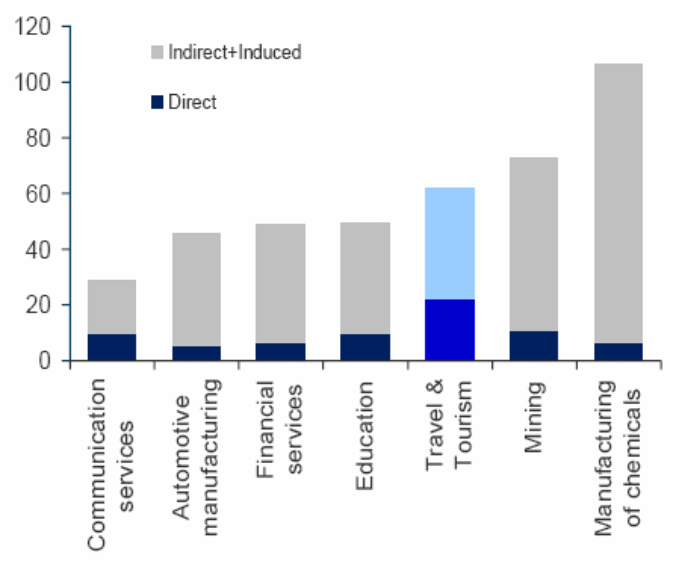
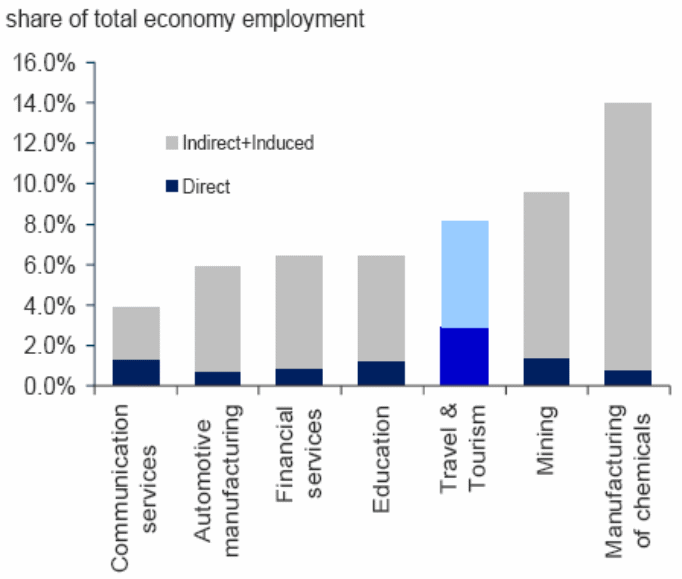
Lui, Kuo, Fung & Jap (2011) and WTTC (2013, p.3) pointed out that the tourism industry is interlinked with other industries for which it influences the whole economy; however, Li & Suomi (2008, p.3) stated that there are more than 17955 travel agencies, and 12750 hotels in China. According to the report of Lui et al. (2011, p.7), this country is anticipated to exceed Japan as the second-largest travel and tourism market in the world through the Chinese market for international travel is still young; however, the next figure demonstrates the fastest growth of China’s Travel Market-
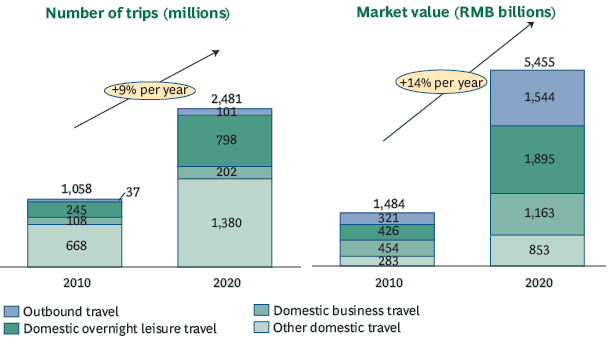
The Conceptual Framework of Heritage Tourism
Poria, Butler, and Airey (2003) pointed that the fashionable word heritage has turned into a significant and most precious component of the tourism industry that emerged and developed very quickly as a special attraction for visitors. Several researchers have noted that the concept of heritage is now considered the major and best sprouting tool for tourism; however, they suggested that it must be handled and promoted especially; Nuryanti (1996) noted that to better understand this increasingly popular concept, it is essential to distinguish between conventional, usual, and constructive rudiments. Previous studies wonderfully pointed out that the concept of heritage tourism is a complex idea that has now turned out to be an attractive option for visitors (Boniface & Fowler 1993; Leask & Yeoman 2002; Leask & Fyall 2012; Prentice 1996; Odhiambo 2012; Garrod & Wanhill 2012; and Lakhotia 2013). However, it refers to a situation where the visit is aimed at understanding the heritage, legacy, or traditional places of historical or environmental importance in any segment of a state (Leask & Yeoman 2002; Leask & Fyall 2012; Boniface and Fowler 1993; Prentice 1996; Odhiambo 2012; and Lakhotia 2013)
However, to explore through the conceptual framework of heritage tourism, it is highly essential to appreciate the fact that the importance of heritage resources and assurance of their longstanding safeguard is vital to gain enduring outcomes from the tourism sector generally; moreover, touring such sites can be of much benefit for tourists in terms of knowledge and awareness gathered. Boniface and Fowler (1993) have further added that long-term heritage tourism can be divided into either physical or intangible concepts for convenience; artistic scenery, famous places, grounds, remaining, archaeological or marine places, ecological legacy, and memorable places of momentous events, may refer to physical heritage, whereas customs, ceremony, credence, societal observance, comprehension, multi-cultures, and tales, may refer to intangible heritage.
According to Poria et al. (2003) and Nuryanti (1996), heritage tourism absorbs a noteworthy quantity of cultural tourism, and when, in certain situations, cultural and heritage tourism offer common characteristics, connecting with different of tourism, ancient magnitude immeasurably notifies the continuum; however, it must not be seen in the context of capricious concern and rather be regarded as a social psychosomatic requirement.
Positive and Negative Impact of Heritage Tourism
Boniface and Fowler (1993) noted that heritage tourism has both optimistic and pessimistic influences from an overall viewpoint; optimistically, tourism activities give the heritage appreciation and acknowledgment by people, which is very important, as otherwise, those places could have been mislaid and not remembered; moreover, this allows travelers to discover and learn the diverse civilizations, backgrounds, and pasts of the world. According to Boniface and Fowler (1993), heritage tourism in a huge industry, creating numerous jobs worldwide; moreover, it brings economic expansion to the neighborhood, and provides the opportunity to expand on the heritage sites and renovate them for safekeeping; however, too much of it can be dangerous for the sites, as people may depreciate the structures or monuments. In certain cases, these activities could necessitate building accommodation for travelers, constructing roads for their convenience, thus making substantial pollution ecologically and adversely influencing the legacies that need much protection.
Heritage Attractions in China
China is extremely enriched not only in terms of cultures, but also in terms of the physical heritages it has preserved for years; according to UNESCO (2013), 45 cultural places in China are emblazoned in world heritage list, 10 places are listed as natural heritages, four are considered as mixed heritages, and 48 places are submitted on tentative-list. However, a brief list of the heritage of the country is given in the figure below:
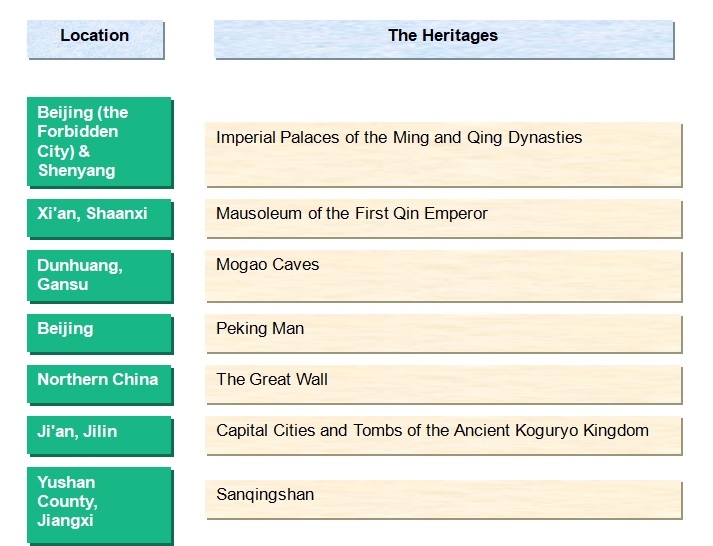
Residents’ Perceptions and Attitudes on Heritage Tourism
Chen and Chen (2010) pointed out that tourism is greatly dependent on the helpfulness of the neighborhood population since it is not possible to flourish without their assistance in long-run; comprehending of neighborhood population’s outlooks and perceptions regarding tourism is crucial for accomplishing the goals to promote heritage-tourism; moreover, the extent of neighborhood contribution is a fundamental ingredient for long-term tourism enhancement. Chen and Chen (2010) added that involvement of the local communities over the planning-process and growth-stages is the basic requirement to ensure permanent improvement; however, these researchers identified that several issues exert an influence on the perceptions and attitudes of communities, which include altitude of their awareness, neighborhood market, and individual financial dependence over-tourism, social issues, etc.
Poria, Butler, and Airey (2003) stated that the materialization of pessimistic attitudes regarding visitors amid natives could disgrace tourism facilities presented at a site; moreover, spiritual faiths of natives is an indication of whether their ideals diverge with the heritage endorsed for tourism on that place; the key apprehension regarding their attitude is linked to their unresponsiveness to aid local-authorities. However, Cengiz (2013) and Uriely, Israeli, and Reichel (2002) pointed out a range of diverse issues that help construct a particular type of observation for the tourism industry among the neighboring communities; these, for example, take account of economy, demography, condition of their relationship with visitors, the closeness of the tourist-attraction site, duration of their living, and connection to conventional customs.
Poria, Butler, and Airey (2003) and Uriely, Israeli and Reichel (2002) suggested that the pattern, living-standards, conducts, ill-manners or different cultures of the tourists sometimes upset or anguish the local civilians and may even be divergent with their cultures; as a result, they could reflect a pessimistic perception towards heritage tourism and be unhelpful with authorities that promote it. Chen and Chen (2010) pointed out that to avoid such troubles and negative attitudes (which can, in the long-run adversely affect the heritage tourism industry and lower revenues), it is highly essential to consult, discuss, counsel, educate, and even engage the local civilians within the entire process so that they can appreciate the need for and advantages of tourism. Some researchers have found out that a helpful local community can help heritage tourism in different ways, for example, by warmly welcoming the visitors, help them see the attractions, guiding them regarding the cultures, educating them of the histories, and finally giving them a sense of excellent hospitality so that their positive feedback can encourage more tourists to come.
ICT Implementation in China’s Tourism Industry
Ma, Buhalis & Song (2003, p.6) reported that the characteristics of the Chinese tourism industry have transformed due to proper implementation of ICT and Internet; as a result, the government heavily intervenes and regulates this sector. However, Buhalis, Song & Ma (2003) concentrated on different sectors of this industry to identify the impact of ICT implication in the tourism industry of China; in addition, the researcher identified that both local and foreign airways (China Southern Airlines, Air China and others) have already integrated Computer Reservation System along with Electronic Distribution system to develop the management system.
Travels Technology Ltd is a prominent state-owned company, which provides IT solutions to the Chinese airline and tourism industry, for instance, 30 home airways, almost 200 local and international airways, 147 domestic airports, and more than 7000 ticket agents, travel agencies, corporate houses, and many others (Gluckman & Hosegood 2013; and Buhalis et al. 2003, p.6). The service range of this service provider includes inventory management solutions, Airport Passenger Processing system, Global Distribution Systems, and Computer Reservation System; however, the following figures show the Travelsky CRS in the Chinese Airline Industry:
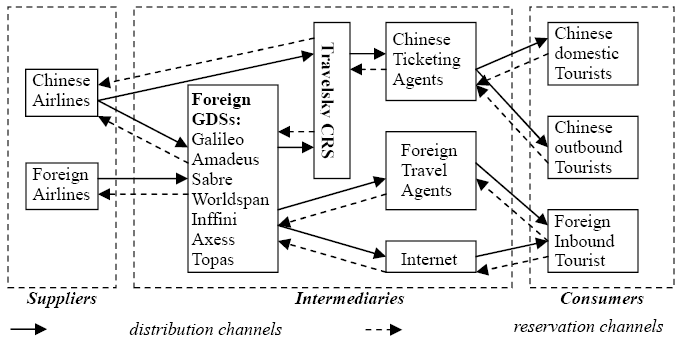
The policymakers and the management team of Travelsky identified that existing websites of the travel agents provide concurrent information, but it is difficult to develop complete GDS and B2B platform or arrange e-ticketing or ticketless travel because of lack of mutual trust for any online transaction (Buhalis et al. 2003, p.10; and Gluckman & Hosegood 2013). On the other hand, the members of this industry have no power or motivation to expand their ICT and Internet strategy; however, the situation is changing day-by-day due to boost of internet users and e-commerce system, which influenced the airlines to implement Internet solutions in their business operation (Gluckman & Hosegood 2013; and Buhalis et al. 2003, p.10).
Recent studies on the adoption of ICT in China demonstrated that government intervention to implement internet solution made it difficult to develop services, for instance, China Southern Airlines and Hainan Airlines tried to introduce web-based ticketing and reservation system, but the project failed because of the CAAC intervention and Travelsky monopoly in the ICT market (Buhalis et al. 2003, p.10).
CNTA (the tourist authority in China started its operation in the 1980s to monitor the function of the tourism agencies, hotels, and tour education institutions; however, it integrated computer network systems in 1992 and more than 90% of employees used a computer with intent to concentrate on accounting, statistics and issuing traveler information CD-ROMs (CNTA 2001; and Buhalis et al. 2003, p.19). CNTA used four SQL servers along with 2m DDN and it developed the website for the tourists in 1997 to promote and provide destination information such as hotels, accessibility, attraction, food preparation, the marketplace, and amusement; however, the following figure shows CNTA system:
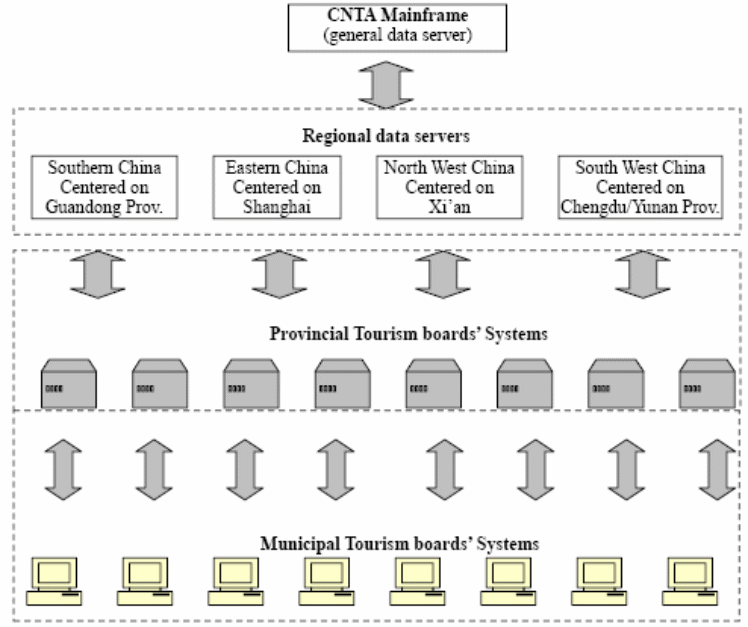
However, there are mainly five problems in China to implement ICT in this industry, for example, lack of synergy among different subdivisions in the industry, shortage of infrastructure required, lack of information service providers and intermediaries, reluctance to know about new facts, and perception of the customers, the information security problems, or data protection (Buhalis et al. 2003, p.20).
Importance of ICT Implication in the Tourism Industry
Shanker (2008, p.3) stated that tourism is at present one of the fastest mounting industries all over the world through the features of this industry mainly based on the service providers, such as accommodation, foods, transportation segment, and so on. Buhalis & O’Connor (2005, p.2) argued that the implication of ICT plays a significant role in the development of tourism organizations and destinations because it empowers the visitors to identify and purchase products and services; therefore, the implication of ICT helps the tourism organizations to maximize organizational competitiveness. However, Shanker (2008, p.3) and Hussein (2010, p.125) pointed out that ICT has a potential impact on the tourism industry since it provided new tools and allowed new distribution channels to develop a new business environment, for example, it enhanced networking and facilitated transaction system in the industry.
At the same time, the proper implication of ICT helps tourists to obtain information, and plan their tour and travel (Shanker 2008; Saroj 2012; Buhalis & O’Connor 2005, p.2; Garrod & Wanhill 2012; and Hussein 2010, p.125). On the other hand, Information is the main element in the tourism business because both local and foreign tourists have selected and identified destination considering Geospatial Information (Shanker 2008, p.3; Buhalis & O’Connor 2005, p.2; Smith & Chaffey 2005, p.125; and Hussein 2010, p.125). At present, many tourism organizations have used Geospatial Information Technologies to gain competitive advantages, for example, attract tourist communities by providing information related to boundaries of the proposed tourist spot, Geospatial environment of the sites, condition of roads, and so on (Shanker 2008, p.3; IFITT 2010, Palmer & McCole 2000; and Hussein 2010, p.125). However, there are various purposes for which it is important to the tourism organizations to adopt ICT, such as:
- Marketing: Nowadays, tourism organizations have used different marketing tools to promote the companies and increase market demand (Shanker 2008, p.3; Buhalis & O’Connor 2005, p.2; Buhalis and Law 2008, p.608; Smith & Chaffey 2005, p.125; and Hussein 2010, p.125). The marketers of tourism organizations intend to change customers’ perception and attitude for which they mainly focus on the company information, economic aspects and discount policy, service range, the attraction in the tourist sites, facilities of the company, and many other issues (Buhalis & O’Connor 2005, p.2; Buhalis & Law 2008, p.608; and Shanker 2008, p.3). At the same time, advertisement and promotional activities also provide a message to the tourists to develop awareness to conserve tourist spot (Hussein 2010, p.125; Buhalis & Law 2008, p.608; and Shanker 2008);
- Operations: ICT played an exceptional function in the development of modern tourism particularly development of the operational management systems has changed the business environment, for example, the CRS system decreased logistic and operational problems and increased sales volume in the airline industry (IFITT 2010, p.29; Shanker 2008; Hussein 2010; and Buhalis & Law 2008). At the same time, buying and management of supplies and services using different software develop an operating system of the sub-industries, such as hotels, entertainment sector, tour operators, road and rail transport, management sector, and other intermediaries (IFITT 2010, p.29; Buhalis & O’Connor 2005, p.2; Shanker 2008; Hussein 2010; and Buhalis & Law 2008);
- Site development: Tourism organizations have used Geographic Information Systems (GIS) to identify Tourist spot and develop the place for the visitors (Shanker 2012; Fyall & Garrod 2005; and Hussein 2010);
- Customer services: Management of customer relationships is one of the significant factors to the players of this industry; as a result, the visitors can take booking facilities and get instant information regarding destination, time to visit, and so on (IFITT 2010, p.29; Shanker 2008; and Hussein 2010);
- Monitoring: Shanker (2008) and Fyall & Garrod (2005) argued that GIS and GPS software are using to manage and monitor tourist sites
Challenges of ICT implication in the Tourism Industry
Recent studies on ICT and tourism revealed that the introduction of new approach and technologies to replace the traditional system in the tourism industry created several problems because the customers used to with traditional intermediaries to book any ticket or gather information on the service (Hussein 2010; Li & Suomi 2008; Bhatnagar & Ghose 2004; and Vrana & Zafiropoulos 2006). However, key challenging factors are low broadband connection speed with government restriction, security measures, privacy policies, socio-economic and cultural issues recruit of inefficient employees, limitation of the small companies for ICT implication, the involvement of multinational players, and so on (Shanker 2008; Li & Suomi 2007; Bhatnagar & Ghose 2004; and Vareiro, Ribeiro & Marques 2011). On the other hand, the high cost of implementation and maintenance of ICT made it difficult for private-owned small companies to take the competitive advantages of modern technologies (Shanker 2008; Li & Suomi 2008; Buhalis & Licata 2002); In addition, high increase rate of distribution channels is a critical problem to organize different segments of this industry.
According to the outcomes of the recent literature, tourism agencies have no opportunity to influence the customers through direct communication for which the private small companies may not like to implement ICT in the operational process (Shanker 2008; Li & Suomi 2008; Lui et al., 2011; and Vareiro, Ribeiro & Marques 2011). On the other hand, the tourist agencies need a skilled labor force to implement and maintain the operational process and to remove technical problems; in this context, the entire system would be expensive comparing with return on investment (O’Connor & Frew 2002; Shanker 2008; Li & Suomi 2008; Lui et al., 2011; Karanasios & Burgess 2008; and Bennett & Lai 2005).
However, the travel intermediaries of developing countries have to face many other challenges, such as limited website speed, failure to give prompt feedback to the inquires of the visitors, outdated content in the website, different perception and attitude of the domestic and international tourists, and so on (Shanker 2008; Li & Suomi 2007; Karanasios & Burgess 2008; and Ma 2003). Furthermore, travel agencies have to focus on the language-related problems for the convenience of the international tourists to attract more customers through the online services (Hussein 2010, p.133; Long 2012, Karanasios & Burgess 2008; Chena & Chena 2010).
Li & Suomi (2008, p.8) presented a survey report of CNNIC and pointed out that only about 3.90% of Internet users are using the Internet to book travel service whereas 63% of the Internet users of the USA are using the Internet for this purpose; in addition, most of the travelers are relying on the traditional service providers. At the same time, the perception and attitude of the local tourists towards ICT implication is not outstanding since the online channels seem not so attractive to local visitors, which demonstrates that E-tourism in this country is still at its initial stage compared with the position of the developed countries (Li & Suomi 2008, p.8). On the other hand, credit cards or other online payment system had not popular to the tourists of the domestic market; however, most of the card users are young and they believe that credit cards contributed to overspending (Li & Suomi 2008, p.9; and Lui et al. 2011).
Perception and attitudes of the tourists after ICT implication in China
Travel China Guide (2011) reported that the inbound tourism of China experienced a fast growth particularly in 2011; however, the main tourist attractions were heritage-sites in Beijing, Shanghai, Xian, and many other cities; in addition, foreign tourist arrivals increased by 1% from last year for which foreign exchange revenue of this industry makes $35bn. At the same time, more than 61% of the total foreign tourist arrived from Asian countries particularly from South Korea; however, the number of foreign tourists is increasing gradually due to the development of different sectors; the next table gives more information to assess inbound tourism segment:
Table 2: China Inbound Tourism from 2006 to 2011. Source: Self-generated from Travel China Guide (2011).
From the above-mentioned table, it can be said that the inbound tourism industry of China experienced rapid growth when the government introduced the Strategy of National Informatization 2006-2020 to integrate ICT in all sectors (Xuesong 2006; Travel China Guide 2011; Ctrip 2011; Elong 2012; and Li 2006). Nowadays, it becomes easy for foreign tourists to gather information about the heritage sites using information and communication technologies; in addition, they can book airlines tickets, hotels, hostels, and others using an online transaction system (Xuesong 2006; Ctrip 2011; Elong 2012; Travel China Guide 2011; and Li 2006). At the same time, the foreign companies can take the opportunity of the free market economy to enter the Chinese tourism market with their advanced communication technologies; therefore, the perceptions and attitudes of the tourists towards the heritage sites have changed rapidly and tourists are interested to visit heritage sites and stay overnight to gather knowledge about culture and heritage.
China outbound tourism market expanded rapidly due to the development of economic position; tourists would like to visit different tourist spots such as South Korea, Malaysia, Thailand, Italy, and many other countries all over the world; however, the domestic tourists are highly relying on the Internet and ICT to collect information to select destination and booking service (Travel China Guide 2011).
ICT implication in the Heritage Tourism of China
Ma, et al. (2003, p.17) conducted a survey among 20 heritage sites and identified that the tourism organizations in the heritage sites (excluding blue Zoo Beijing and World Park) had not used advanced communication system including e-commerce system; moreover, the organizations did not apply information network in operational process, but few firms use the Internet to send a message. However, Ma, et al. (2003, p.17) further addressed that the tourism organizations of these two sites had experienced huge success in case of cash management and acquiring market statistics; therefore, other tourism agencies, tour operator, and hotels had tried to incorporate ICT to operate and control business more effectively, but it was a difficult task because of lack of foreign investment. At the same time, tourism agencies of heritage sites had faced other problems to adopt ICT, such as outdated perception and attitude of the tourism organizations and customers to trust on modern technology, satisfaction with the traditional operating and cash management system, and unwilling to transform the system (Ma, et al. 2003, p.17).
On the other hand, the government noticed to the heritage tourism organizations to update websites before 2001, but the management of these sites ignored that suggestion for which most of the websites were inaccessible. Furthermore, the tourism organizations in the heritage sites were unwilling to use advanced technology and to explore eCommerce due to lack of sales volume; however, some organizations had incorporated touch-screen computers on sites (Ma, et al. 2003, p.18). However, the incorporation of ICT in heritage tourism organizations increased from 2006 to target specific communities while the government had introduced the Strategy of National Informatization 2006-2020 to develop the application of CAD/CAM and MIS, ERP, SCM, and CRM (Xuesong 2006; and Li 2006).
Different E-Marketing and ICT based Websites of HVAs in China
According to the annual report of Ctrip (2011), Ctrip.com International, Ltd is one of the largest service providers in the leisure travel market, which offers variety, quantity, and quality of the products and services in the marketplace, for instance, its hotel network includes more than 200000 international along with 39000 domestic hotels. However, www.ctrip.com is the most popular sites to the hotels, tour operators, airways, travelers, and other related organizations and individuals since it incorporates proprietary booking software in the sites and more than 40% of the total transaction of the company executed through its websites; this company uses both Chinese and English language in the websites (Ctrip 2011, p.33). This company uses advanced technology to reduce the time and efforts of the people, for example, customers need a short time to complete a booking online; in addition, it has more than 9 thousand trained customer service representatives to help the tourists and provide extra information using advance communication tools (Ctrip 2011, p.33).
On the other hand, tourism organizations use this website to promote products and services, conduct public relations activities in the different cities in China, develop cross-marketing relationships, use online marketing facilities, and enhance customer rewards program. At the same time, Ctrip.com always incorporates and checks security measures to ensure compliance with domestic law particularly the law of transactions on the Internet to avoid legal challenges since the Supreme Court of China issued judicial interpretations to protect online customers from illegal online activities (Ctrip 2011, p.21).
According to the annual report 2011 of this company, ctrip.com has different subsidiaries to enhance facilities, such as, it has hostel-booking website Songguo.com and vacation rental booking website Tujia.com, Lvping.com consolidates travel-related information for travelers; moreover, it introduced a new travel brand “HHTravel.com’ to serve high-end tourists of China with super deluxe tours. Most of the visitors arrived in China from different countries and they use an e-ticking system of ctrip.com to reserve seats, otherwise, they would not get the opportunity to visit the heritage site without the hazards of travel to a new place.
Yahoo Finance (2013) reported that eLong, Inc. is the direct competitor of Ctrip, which established in 1999 to provide online travel planning and booking facilities; it has about 200000 domestic and international hotel networks; moreover, it adopts innovative technology to allow tourists to provide information about accommodation and air ticket booking decisions by using its websites and mobile applications. At the same time, according to the annual report 2011 of this company, Expedia, Inc. is the largest shareholder of long; however, it has two prominent websites, such as www.elong.com and www.elong.net (Yahoo Finance 2013; and Elong 2012).
Other national and international companies are operating a business through prominent websites; such as Mangocity.com, Qunar.com, Taobao.com, Hotels.com, and Hotwire.com are the major competitors in the online travel booking industry; among these sites, Expedia.com controls Hotels.com and Hotwire.com (Yahoo Finance 2013; Ctrip 2011, and Elong 2012). At the same time, www.travelchinaguide.com provides very useful information to the customers through the wonderful websites and it has about 16,000 hotels booking in above 600 cities in China (Travel China Guide 2011); in addition, www. dongnanya. travel/ organizes tourism digital campaign for China to implement a long-term goal to develop this sector.
Literature Search of the Previous Research
Table 3: Literature Search of the Previous Research. Source: Self-generated.
Scopes of the study
To reach successful outcomes, the author of this study has the following scopes with this research area:
- The author has the opportunity to scrutinize the overall tourism statistics of China from the National Bureau of Statistics of China (NBC) and China National Tourism Administration (CNTA) online from their websites;
- In addition, the author has the chance to examine how the heritage tourism trend of China changing quickly by using ‘The Yearbook of China Tourism Statistics’ published by China Tourism Press, which is available online;
- The researcher also scrutinizes with the official orders, regulation, and policies those are proclaimed by China National Tourist Office (CNTO), Cultural Heritage Foundation (CCHF), and Chinese World Cultural Heritage Foundation (CWCHF);
- Moreover, this research has the opportunity to observe the ICT strategy of China introduced by the Ministry of Industry and Information Technology (MIIT);
- However, the paper has further scope to examine the theoretical framework of heritage tourism, its historical background, and effectiveness to the future generation, cultural linkage, and existing regulations related to the conservation of heritage sites in China and Chinese role in the global heritage tourism sector.
Research Methodology
Research Design
The prime objective of this chapter is to design a methodological framework to explain the Perception and attitude of tourists towards ICT implication in the Heritage Tourism of China. However, the next figure shows that both qualitative and quantitative approach will be used for this dissertation:
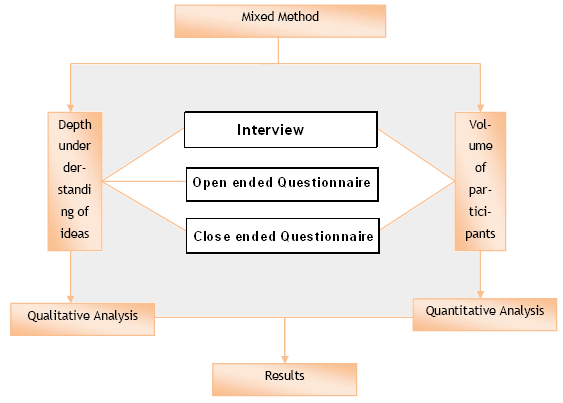
Quantitative Research Method
The methodological framework of Sekaran (2006), Malhotra (2009), Manion & Morrison (2007), Boeije (2009), Yin (2003), and many others stated that the quantitative research method seeks to quantify primary data by using statistical formulas and numbers; at present, researchers use different tool and software to conduct research. However, Baggio & Klobas (2011) stated that both academics and practitioners have relied on the quantitative research method to explain collected information through numbers and formulas had not used significantly in the tourism research since this statistical approach is very sophisticated, but sometimes complicated to understand by the readers. In this dissertation, the primary data for the quantitative research will be collected from the tourists in China (both domestic and international tourists); however, the aim to target them is to assess their perception and attitude towards ICT implication in the Heritage Tourism sector in this country.
Qualitative Research Approach
Qualitative research usually aims to know the experiences, attitudes, and some aspect of the social life of the respondents and reply to the questions regarding the ‘what’, ‘how’ or ‘why’ of a phenomenon (Patton & Cochran 2012; Creswell 2007; ILRT 2011; Cohen, Manion & Morrison 2007; Yin 2003 and Zikmund 2006). Moreover, it is the most appropriate and rigorous way of answering though the disadvantages of this approach include the findings lack of rigor and small sample size to generalize the result (Patton & Cochran 2012; Creswell 2007; ILRT 2011; Rajendran 2001; Saunders, Thornhill & Lewis 2006; Keegan 2009 and Creswell 2005). Qualitative data can strongly support quantitative data by identifying the extent of the problems and providing a more complete picture of the investigated phenomenon (Patton & Cochran 2012; Boeije 2009; ILRT 2011; Rubin & Babbie 2010; Burney 2008 and Ortega 2002).
In this situation, this paper would use thematic analysis procedure and an explanatory approach of qualitative research to describe the data gathered from the in-depth interviews; however, a qualitative questionnaire would assist get a response about the perceptions and attitudes of the tourists after implementation of ICT in the Heritage Tourism industry of China. The employees of the tourism organizations have enough experience to provide a descriptive answer about the potential use of ICT tools and the significance of ICT tools in the tourism industry for marketing, operation, and management; in addition, they have practical knowledge about the perception, attitudes, and behavior of the tourists after implication of ICT.
Primary data
Most of the prominent authors such as Sekaran (2006), McLeod (2011), Malhotra (2009), Moustakas (1994), Pannucci & Wilkins (2011), and many others expressed that primary data is collected especially to concentrate on the dilemma in question at hand; however, it needs to collect using different method like survey, in-depth interview, and observation. To obtain primary data, the Likert scale in the structured questionnaire will be used because the tourists can focus on different issues that are not relevant to analyze the perception and attitude of the visitors towards ICT implication in the Heritage tourism industry.
Secondary data
Secondary data is generally available in published and electronic form; however, this data is used for some reason other than the problem at hand (Finn, Elliott-White & Walton 2000; Marshall & Rossman 1999; and Richey & Klein 2007). The main advantages of this data are the authentic source, inexpensive in terms of time and efforts, easy to access, and so on; however, it may have limited applications to particular research.
Sample Size
The research will select a large target group for the quantitative research (80 tourists both from national and international) and a sample target group for qualitative research (15 employees of five hotels); however, the following table provides a short description of the respondents for quantitative research:
The sample size for quantitative research:
Table 4: Description of the respondents for quantitative research. Source: Self-generated.
The sample size for qualitative research
To conduct qualitative research, the research will consider a small number of respondents, for instance, fifteen employees from five tourism organizations will be interviewed to know about the tourists’ attitude toward ICT in heritage tourism in China. However, the following table gives more information about the tourism organizations:
Table 5: Description of the respondents for qualitative research. Source: Self-generated.
Data Collection Method
The researcher will consider in-person Interviews to obtain completed surveys instantly though this process is costly to conduct, and participants may not be ready to disclose some information about themselves to the interviewers; therefore, the researcher has to take permission from the tourists and the selected tourism organizations in China. This study will not consider online survey as people are not willing to take part in the survey and the commercial surveyors ask high price to conduct such a study, thus the researcher was obliged to the willingness of the respondent who contributed with their valued time; on the other hand, secondary data will be collected from:
- Books and journal articles on hospitality and tourism management and heritage tourism of China.
- Guide, directories, index, and statistical data.
- Census Data and Other Government publications.
- Computerized Database and websites of tourism organizations.
- Report of international institutions like UNESCO.
Instrument
Surveys take many different forms and styles, such as face-to-face interview when the researcher directly asks questions to the respondents, online survey when the researcher design an electronic questionnaire to get a reply from the individuals without any direct communication (ILRT 2011, p.1; Malhotra 2009; Sekaran 2006; McLeod 2011; Leung 2012; and Munhall 2011; and Trochim & Donnelly 2006). However, there is no specific system to design a questionnaire, but the research needs to focus on several issues, such as aims and objectives of the research, perception, and attitude of the respondents, educational background, socio-economic position of the individuals, and wording of the questionnaire to understand by the general people and so on. However, the next table gives more details to understand the content of the questionnaire to analyze the perception and attitude of the tourists toward ICT implementation in this industry-
Table 6: Contents of the questionnaire. Source: Self-generated.
Data Analysis
Qualitative data analysis is less technical and less prescribed than quantitative analysis; however, the key challenges of qualitative data analysis are reduced data, identify categories and relations, and present well-reasoned, the generalization of ideas, and reflective conclusions (Finn, Elliott-White & Walton 2000; Munhall 2011; Rubin & Babbie 2010; Malhotra 2009; and Veal 1997). On the other hand, different participants to the same question obviously will reply differently, for instance, use different concepts or phrases; therefore, it is essential to focus on transcripts of interviews to create categories for coding to interpret the emerging themes (Miles & Huberman 1994; Rubin & Babbie 2010; Malhotra 2009; Cooper & Schindler 2001; and McNabb 2010). The researcher will convert data in the word document to reduce data, then categories to get the main theme of the respondent without bias; in addition, the researcher will only focus on the perception and attitude of tourists towards ICT implication in the Heritage Tourism of China.
On the other hand, quantitative data will be codified into categories to measure the percentages and central tendency (the mean is the most helpful way) by using Microsoft Excel; however, a bar chart will be used to present data in this dissertation to analyze the perception and attitude of tourists towards ICT implication.
Ethical issues
The authors should have responsibilities to the research participants, such as, respect the rights of the individual, and not doing harm (Patton & Cochran 2012; Leung 2012; Addington-Hall, Bruera & Payne 2007; and Munhall 2011). The research will focus more on the research field, but must not include any humiliating, and painful question in the questionnaire to avoid misunderstanding as uncomfortable questions may create distress during an interview (Leung 2012; Patton & Cochran 2012; McLeod 2011; and Daly & Lumley 2002). At the same time, consent and confidentiality are the main ethical concerns to the researcher of the study; however, other ethical considerations are:
- This dissertation will contribute to the area of hospitality and tourism management field;
- The identity of the target respondents must be protected at all times and data not be left in a computer without protection;
- The researcher will equally treat the opinion of both tourists and the employees of tourism organizations to gather information about the perception of tourists toward ICT implementation;
- The author will not be taken data from disabling and the people under 18;
- both tourists and the employees of tourism organizations should be well-informed about the subject matter, data collection, and related issues;
- Prepare questionnaire carefully as both researcher and the participants can be biased;
- Finally, the researcher will take information from secondary sources using Harvard referencing style
Limitation of the Study
- The research has taken a medium sample size to conduct quantitative research for this dissertation and select a direct interview process to avoid any misunderstanding; therefore, it should require a long-time for data collection while the submission deadline is coming soon;
- This researcher has faced a basic problem to interact with the tour operators, as the concept of heritage tourism has linked with the ‘diversity of tourists’ which is confusing to the travel agents and mostly amalgamate with the other types of tourism like adventure tourism, cultural tourism or green tourism;
- The employees of five selected hotels will provide their opinion willingly, but they can hide some information regarding their business for which it would be difficult to assess the perception and attitude of the tourists toward ICT implementation on heritage tourism;
- On the other hand, both employees of hotels and visitors of different countries can show reluctance to complete the entire questionnaire as it should take a few minutes;
- At the same time, the participants particularly tourists are not highly aware of the impact of ICT on the tourism industry and the role of IT to reduce the time and efforts of the customer. As a result, it would be difficult for the tourists to realize the concept of the questionnaire to some extent;
- The allocated deadline was also another limitation for this research
- As the heritage sites are in diverse location and there is no financial allocation for this study; therefore, it was difficult to interview the tourists face-to-face and it should require the additional fund to collect primary data
Findings and Analysis
The main purpose of the findings chapter is to scrutinize the results of the actual survey conducted to analyze and evaluate the perception and attitude of tourists towards ICT implication in the heritage tourism industry of China. To do so, a survey has been conducted between two different groups of interviewees, namely, among the tourists from around the world, particularly from Europe, Asia, North America, South America, Australia, as well as domestic tourist of China, and among the employees of the hotels. It is decisive to state that the questionnaire was distributed to 80 tourists and 15 employees; therefore, for convenience, this chapter deals with two separate sections; the first section focuses on the perception and attitude of tourists, and the second one focuses on employees’ opinions.
Section A: Perception and Attitude of Tourists
The respondents were asked to stipulate their name, nationality, and gender
To begin with the research, the respondents were asked to answer this preliminary question; nevertheless, to conform to the data protection legislation, it is neither feasible nor ethical to convey this information in this research.
The respondents were requested to select their highest education levels
To better understand the respondent groups and assess their respective responses accordingly, it was highly essential to know the exact figures of their education levels. It has been found that 5 percent people studied at the school level, 27.5 percent people studied at the college level, 40 percent studied in an undergraduate degree, 25 percent studied in postgraduate degree, and 2.5 percent studied other professional qualification; this is shown in the figure below
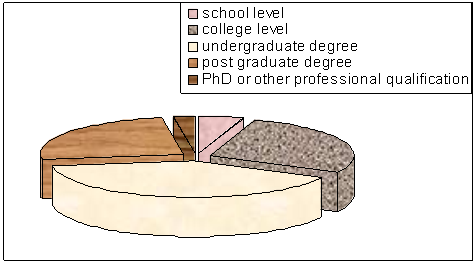
The respondents were requested to select their age groups
At the initial stage of the research survey, it was vital to know about the age orientation of the interviewees; this is because this data would help the researcher by giving the idea about the features, traits, and natures of the people who have helped the survey by giving their valuable responses. After assessing the provided responses, it is noticeable that 15 percent of people aged from 18 to 27, 27.5 percent people aged from 28 to 37, and 37.5 percent people aged from 38 to 47. On the other hand, 12.5 percent people aged from 48 to 57, and 7.5 percent people were 58 or above; however, for convenience, the following graph is given to illustrate this in more detail, which shows that the majority of the population aged from 28 to either 37 or 38 to 47:

General Information about tourists
This question has been subdivided into three questions to better understand tourists’ behavior in the particular context.
Whether the respondents use Google or Yahoo to get information about trips and destination
This part of the research survey tried to find out whether, or to what extent, the surveyed population uses search engines such as Google or Yahoo to get information about trips and destinations. This would provide the researcher with an idea about the number of people who are more likely to incline to ICT implication in case of decision-making while selecting the place to visit. There is no doubt that in this era, while the progression of science and technology is reaching the highest peak, people from any part of the world are highly likely to at least conduct a small scale study regarding the place where they are wishing to visit. As a result, most of the people who were surveyed in this research have been more interested in selecting the yes option; to specify, 85 percent people have selected the yes option, whereas 15 percent people have selected no option; this is briefly outlined in the chart below:

Whether the respondents get the benefit of ICT
It is notable that in this twenty-first century, ICT embraces the world from all spheres starting from the more rapid right of entry to information technology, superior inter-functionality and administration of tools, expenditure efficient exploitation in well-fabricated IT infrastructure, towards uncomplicated and spontaneous edges, information communication technology has made people around the world too obstinately dependent on the internet. This means that people have got used to ICT and it has increasingly turned into an essential feature of everyday life; as a result, it can be deduced that if there were no benefits of ICT, people would not have been using it in such a regular basis. Therefore, not quite surprisingly, the surveyed population has also agreed with this point; to specify, about 70 percent of people have selected the “yes” option, and 30 percent of people had selected the “no” option. However, the figure below shows that most of the people in the survey have inclined to the benefits of ICT:

Whether tourism organizations provide the respondents promotional message through e-mail, mobile or social media
This question aimed to find out the extent to which the tourism companies are engaged with their customers through different methods on the internet. Through giving a promotional message through e-mail, mobile, or social media, it would be possible for these companies not just to increase their customer base or persuade them towards using their respective services, but on the other hand, it would also increase the company’s brand name, public image, or public relations. As a result, without any doubt, the concerned activities by the businesses can enhance their overall performance.
However, in most cases, one of the biggest hurdles that these companies face is the threat of such mails or communications being regarded as “spam mails” by the customers, which can have the effect of restricting the corporate performance and the ability of the company to aware an increasing number of customers and increase the annual turnover. It is notable that even though most of the local tourism-based companies in China are not fully integrated technologically when it comes to mailing people and alerting them, the numbers of such businesses are not so ignorable. It is indispensable to say that most of the surveyed people have agreed to this logic and contributed to the findings that most of the companies provide them with promotional messages. In answering this question, 80 percent of people have selected the yes option, and 20 percent has no, as shown in the figure below:
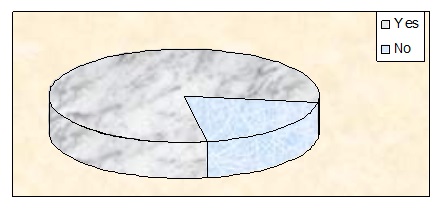
To what extent the respondents agree that tourism organizations provide a regular update about heritage tourist site and their services after the implementation of ICT
The researcher has put this question forward to assess the degree to which the tourists feel that the concerned companies provide them with a daily update about heritage tourist sites and their services after implementation of ICT. At this point, it is necessary to make it clear that not all such companies have integrated their services into the IT infrastructure and so it is not possible for all companies to provide regular updates. This question, in particular, only addresses those businesses, which are fully scientific or which have fully introduced themselves on the internet. However, it is essential to know the fact because this would help the research by identifying the insight and stance of visitors after the introduction of information technology in the tourism sector. After conducting the research survey, it had been possible to reach the conclusion that in answering this question, 15 percent of people have strongly disagreed that tourism organizations provide a regular update about heritage tourism sites and services, 17.5 percent had disagreed with it, and 2.5 percent had no opinion. On the other hand, 30 percent people have agreed to this point, whereas 35 percent has strongly agreed; however, the mean is 3.525, which indicates that the major number of people agrees that the particular service has improved:

To what extent the respondents agree that the tourism organizations provide sufficient information to change the perception and attitude of tourists to protect heritage site
It is not quite surprising that the perception and attitude of tourists are not always quite optimistic, friendly, mature, ethical, and responsible; more often, many visitors destroy, distort, or alter the sensitive heritage sites; as a result, it is vital to take actions to protect these sites. However, this question aimed to identify the extent to which, in the view of respondents, the tourism organizations are aware of all these risks and whether or not these firms are responsible enough to take proper action to smartly handle this problem and provide sufficient information to change the perception and attitude of tourists to protect heritage. In responding to this question, 8.75 percent of people strongly disagreed that the tourism organizations provide sufficient information to change the perception and attitude of tourists to protect heritage sites, 30 percent people disagreed with the proposed statement, and 3.75 percent people had no opinion. On the other hand, 25 percent people agreed to this question and 32.5 percent people strongly agreed to this; however, the mean is 3.425, which indicates that most of the surveyed population inclined to say that they agree to this statement, as shown below in the chart:

To what extent the respondents agree that the effectiveness and user-friendliness of the websites of tourism organization are beyond doubt
To assess and understand the perception and attitude of tourists towards ICT implication in the heritage tourism of China, it is highly significant to know the level to which the interviews think that the efficacy and user-friendliness of the websites of tourism organizations are reliable and accurate. This will be judged in terms of giving information, making regular updates, and offering other necessary services using their respective websites. After conducting the entire research survey, the researcher has been able to come to the deduction that the visitors who have been surveyed have leaned towards the “disagree” option, as the mean was 2.6125. As a result, it seems quite clear that most of the people who love to visit China are not quite satisfied with the quality of services provided by tourism-based businesses.
Furthermore, if those concerned businesses fail to respond well though dynamic adaptation of swift technologies in this age of IT advancements, the dissatisfaction among customers will continue to increase and hamper the tourism sector of China, affecting its gross domestic product and lowering other economic indicators, as a huge amount of national revenues of the country come from tourism. It is important to state that after conducting the survey, it is clear that 37.50 percent people have strongly disagreed that the effectiveness and user-friendliness of the websites of tourism organizations are beyond doubt, 22.50 percent people have disagreed to point, and 3.75 percent people had no opinion to this. However, it is notable that 13.75 percent of people have agreed to this point, whereas 22.50 percent of people have strongly agreed to the proposed statement.
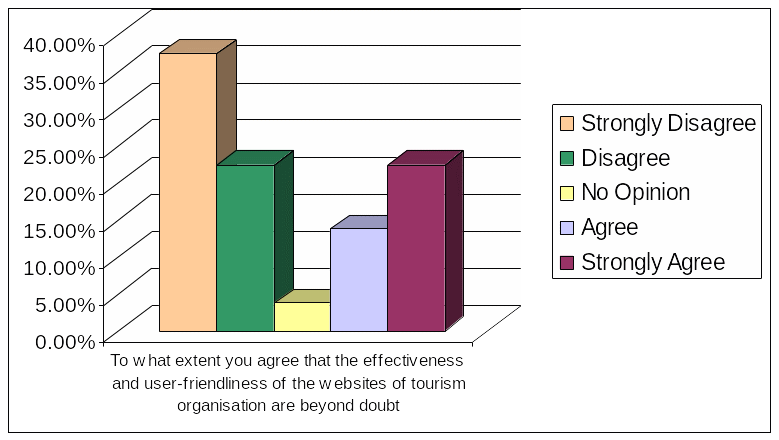
Whether the respondents think that an electronic payment system is more effective than a traditional system for booking
The researcher put this question forward because if most of the people agree to the proposed statement, it would be clear that the perception and attitude of the visitors are quite optimistic when it comes to ICT implication in the heritage tourism industry of China. However, before starting the exact figure of those people who have agreed or disagreed with this, it is significant to make clear several points. First, it must be taken into consideration that there are significant numbers of the population of tourists, specifically in China, who believe that the traditional methods are far more effective and user friendly than the new ones.
The logic behind this idea is that in the traditional method, people have a chance to bargain the prices charged and lower the overall costs of the journey. Secondly, it is also vital that such people often do not rely on the accuracy and truthfulness of the information provided in online media and believe that certain information, such as attractive sites, available hotels, booking facilities, etc. could be erroneously stated here. As a result, the survey has revealed the fact that 45 percent of people have strongly disagreed that an electronic payment system is more effective than a traditional system for booking, 30 percent people have disagreed with this, whereas 2.5 percent people had no opinion. On the other hand, 8.75 percent of people have agreed to this point, and 13.75 percent of people have strongly agreed to this. The mean is 2.1625, which indicates that more people have selected the disagreed option, as shown in the graph below:

ICT implementation by the tourism organizations save time and efforts of the tourists
In answering this question, most of the respondents have agreed that by implementing ICT, the time and efforts of the tourists are saved largely. The mean is 4.1125, which indicated that most of the people strongly believe the proposed statement. For example, 7.5 percent of people have strongly disagreed with this, 11.25 percent people have disagreed with this, whereas 3.75 percent people had no opinion. Moreover, 17.5 percent people have agreed to this, whilst 60 percent people have strongly agreed:

To what extent the respondents agree that tourism organizations provide a prompt response after implementation of ICT
This question aimed to get a better idea about the performances of the concerned companies after adopting ICT and identify whether they have been able to exploit the IT infrastructure successfully. It was notable that 16.25 percent of people have strongly disagreed that tourism organizations provide a prompt response after implementation of ICT, whereas 20 percent people have disagreed with this and 1.25 percent people had no opinion. On the other hand, 23 percent of people have agreed to this proposed statement, whist 40 percent of people have strongly agreed to it. The mean was 3.45 that show that the majority of the surveyed population has agreed to this:

To what extent the respondents agree that tourists trust the ICT system as it takes good care
This question tries to address the overall reliance of the tourists over the information technology procedures in terms of the assistance it provides. Notably, 8.75 percent of people have strongly disagreed that they trust on ICT system as it takes good care, 12.5 percent people have disagreed to this, where as 2.5 percent people had no opinion to this concern. However, 22.5 percent people have agreed to this, whist 53.75 percent people have strongly agreed to the question; the mean is 4, which means most of the people have agreed to the statement, as shown in the graph below:
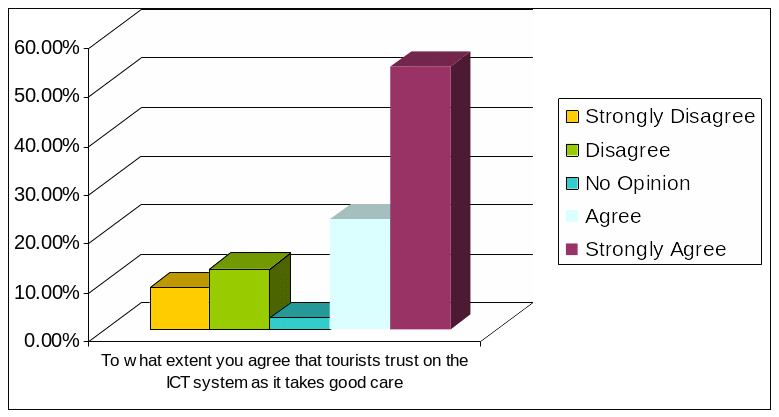
Whether the respondents agree that tourism organizations should adopt and develop ICT in business
With the mean of 3.725, there is no doubt that the majority of the surveyed population agreed to the proposed question. The reason behind this is that most people believe that only through a proper IT integration, any business can provide a good service to the customers efficiently and smartly. In addition, even though China is developing its industry in this sector, in fact, from an overall sense, the country has developed in the IT sector and the majority of the population of the country are now under the umbrella of information and communications technology. Therefore, about 6.25 percent of people have strongly disagreed that tourism organizations should adopt and develop ICT in business, 15 percent people have disagreed with this, whereas 3.75 percent people had no opinion. Conversely, 50 percent people have agreed to this, and 25 percent people have strongly agreed to this:
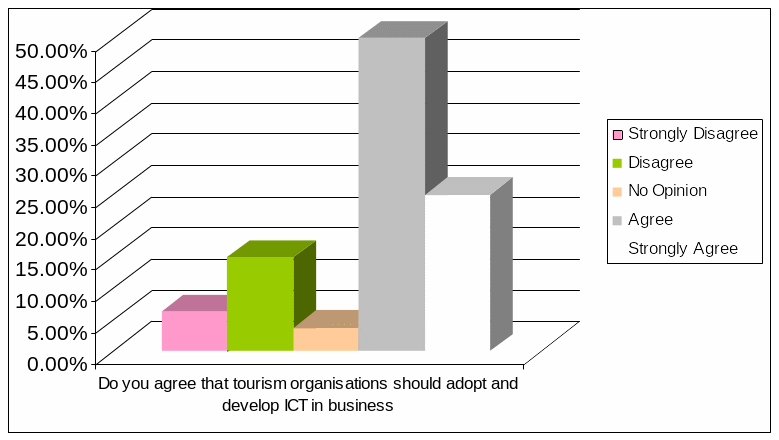
Section B: Employees’ Opinions
The respondents were asked to state their name, nationality, and gender
This was a general question to know some basic information about the respondents.
Common questions to the tourism organizations
Whether the respondents’ companies have any website
All of the interviewees pointed out that their respective companies possess a corporate website.
Whether the respondents have integrated ICT and internet facilities
As the research tried to identify the perception and attitude of tourists towards ICT implication in the heritage tourism of China, it was important in this part of the paper to select only those respondents who have integrated ICT and internet facilities. Therefore, all respondents had integrated ICT and internet facilities, although the extent of this integration varied.
Whether the respondents have integrated e-commerce system
Almost every interviewee had integrated e-commerce systems with different proficiencies.
The respondents’ opinion regarding the perception and attitude of the customers towards ICT implication
Most respondents pointed out that in the current age of technological advancements, ICT fastens the world from all aspects; as a result, information technology is now in the hand of everyone. They noted that as far as attitude is concerned, the customers positively take the ICT implication and rather appreciates it. However, even though the perceptions regarding these issues are also clear among a group of customers, several customers exist who possess an observation that using services from companies that have made ICT implication will take high charges, as there will be no option for a bargain and may also provide unreliable information. The respondents also pointed out that without a change in such attitude, it will not be possible for such businesses to flourish and sustain in the long-run.
Whether the respondents get any change in customers’ behavior towards Heritage Tourism after integrating ICT
The respondents noted that in the initial years of their ICT integration, a group of customers existed who found it difficult to cope up with the new processes. However, with elapse of time, they became used to the new facilities and now they are able proficiently to use the services. In addition, as the respondents stated, some customers still exist who are unwilling towards ICT integrated heritage tourism due to several factors. They noted a mixed set of changes in customers’ behavior and suggested that a major group of customers possess an increase in demand after integrating ICT.
The respondents were asked to state the main obstacles to the tourism agencies to adopt ICT in the operational system in the Chinese market
Most of the SMEs and other tourism organizations have possessed communicating devices and tried to adopt ICT, but it is difficult to use such technology on business due to lack of knowledge of the employees and the management; however, they are not willing to arrange or receive training process to develop skills to manage communication devices. The employees of five selected hotels argued that imbalance growth of ICT between the developed region and developing region create hindrance in the operational and management system since the tourist of different zone react differently. The respondents argued that the government introduced a long-term strategy and new act to develop the level of implication of ICT in the tourism industry and other business segments, but unfortunately, it becomes difficult for the policymakers, ICT service providers, and business organizations to implement this strategy in the operational system in the Chinese market.
Whether the respondents think tourism agencies can use the facilities of the advanced technology
The respondents suggested that although numerous agencies can exploit the facilities of the advanced technology, there are different barriers and costs involved in utilizing the facilities of the advanced technologies, and stated that only businesses with good finances and resource and capabilities can successfully come out of those hurdles and fully utilize the facilities. However, in their point of view, China is developing from all spheres when it comes to using IT infrastructures and so in near future, all the local tourism agencies can fully exploit the facilities of the advanced technology.
Whether the respondents have any recommendation for further development of Heritage Tourism of China using ICT and the internet
The respondents have made numerous recommendations for further development of Heritage Tourism of China using ICT and the internet; they suggested that it is highly essential to construct a proper IT infrastructural guiding principle, progress competency creation, conduct awareness programs regarding how to use the services, augment transmission intermediaries, and react quickly to clients’ requirements.
Recommendations and Conclusion
Recommendations
At this stage of the paper, it is essential to state that China is continuously developing its heritage tourism sector and introduction of ICT in this regard has raised the prospect of achieving exceptional results. However, after conducting the entire research, it is notable that the implication of ICT, to certain extent, has not been able to change the perception and attitude of tourists completely in an optimistic manner; therefore, considering the loopholes, the following recommendations can be made:
- It is important to ensure that the concerned service providers are able to update the related websites routinely; this is because even after implementation of ICT, certain tourists have complained that the information is not updated regularly. Therefore, the online services require renovation and modification so that the service providers are able to react quickly to clients’ requirements.
- In order to avoid the common grievances, such as wrong information provided in the websites, the tourism organisations must first research through the heritage spots comprehensively, and formulate the IT amenities accordingly, which should be fully equipped with correct and sufficient information.
- In addition, some of the tourist respondents who were interviewed indicated that they are not largely satisfied with the effectiveness and user-friendliness of the websites of the tourism organisations. Therefore, the IT facilities should be developed aptly, considering the fact that the customers may not be able to spend a great deal of time, patience, and effort in exploring through complicated websites.
- Conversely, it is vital to consider the fact that some customers are too conservative towards trying new things, for example, the survey has indicated that a number of tourists do not believe that the new electronic payment system is more effective than traditional system for booking. This is due the idea that in traditional method, they have a chance to bargain the prices and lower the rates; so, it is crucial to ensure two things. Firstly, the online services must be cost efficient; so, the rates are as low as traditional systems, and secondly, proper awareness programmes must be conducted among people to augment their knowledge regarding the uses of ICT.
- A proper IT infrastructural development is vital to ensure a sustainable economic enlargement for the country, and long-term success in the industry; therefore, the concerned service providers must do much investment, and research in developing the technical facilities and ensure that they are providing prompt responses after implication of ICT;
- It is important to argue that the implementation of the strategies that China had undertaken to execute between 2006 to 2020 period has not progressed substantially from all spheres. As a result, it is vital for the country to make sure a strict implementation of those strategies particularly, in order to achieve groundbreaking success, and so the national policy-makers should start working accordingly.
- It is vital for everyone associated in this sector to overcome the language barriers and convey the best possible IT services to the prospective tourists around the world, as well as the domestic ones.
- Hacking is a major concern in the Chinese society; consequently, it is important to ensure strict security of credit cards; however, since China is excellent in terms if IT development, it can overcome this problem effortlessly.
- The privacy policies of the websites should be reconstructed ethically, considering the relevant legislation and ensuring the safety of the information provided by the customers; otherwise, customers will not be interested to get involved here.
Conclusion
This paper scrutinized the literature of previous study and identified that Chinese tourism organisations started to incorporate ICT applications particularly airline industry strongly adopted modern equipment and system to communicate with the employees and tourists, booking tickets and other customer care services, which attract both domestic and foreign tourists. However, the government has designed strategic goal for more implementation of ICT in the tourism sectors, but the domestic organisations (mainly hotels, tour operators and other HVAs) have failed to take benefits of ICT for many reasons, such as, unwillingness of the people towards new technology, high implementation costs for the small companies and so on.
After assessing the survey, and evaluating the results, it is notable that the perception and attitude of tourists towards ICT implication in heritage tourism of China is quite optimistic from an overall viewpoint; however, due to a number of technical deficiencies and an observation among people that traditional system is less costly, the industry is still not getting enough development. In addition, it is important to note that in order to attain successful outcomes; it is significant for the concerned bodies to identify the latent loopholes and challenges, and take proper steps to modify those according; however, some of these are indicated in the recommendation section. Nevertheless, it is notable that China is a prospective country not only in terms of the outstanding heritages it has, but also because of the fact that it has strong IT infrastructure and competent human resources; therefore, the chances of success is predictable.
This research has pointed out several problems to assess the perceptions and attitudes of tourists to the ICT implication in practice of heritage tourism in China; therefore, further research should focus on the above-mentioned problems in order to get more solution to develop heritage tourism industry of China in the future.
Reference List
Addington-Hall, J. M, Bruera, E & Payne, S 2007, Research methods in palliative care, Oxford University Press, Oxford.
Alford, P & Clarke, S 2009, Information technology, and tourism a theoretical critique. Web.
Argyropoulou, A. Dionyssopoulou, P. Miaoulis, G 2013, Tourist Destination Marketing and Management Using Advanced ICTs Technologies. Web.
Baggio, R & Klobas, J 2011, Quantitative Methods in Tourism. Web.
Boeije, H 2009, Analysis in qualitative research. SAGE Publications Ltd, London.
Boniface, P., & Fowler, P 1993, Heritage and Tourism in “The Global Village”, Routledge, London.
Brookins, M 2013, The Advantages of Using Social Media Marketing. Web.
Brown, E 2010, How implementing social media strategies (the right way) attracts customer loyalty. Web.
Brussee, R & Hekman, E 2010, Social Media Are Highly Accessible Media. Web.
Buhalis, D. 1998, Strategic Use of Information Technologies in the Tourism Industry, Pearson prentice Hall, London.
Buhalis, D. & Jun, S. H 2011, E-Tourism. Web.
Buhalis, D & Law, R 2008, ‘Progress in information technology and tourism management: 20 years on and 10 years after the Internet- The state of eTourism research’Tourism Management, vol. 29, pp.609-623. Web.
Buhalis, D. & Licata, M. 2002, ‘The future of eTourism intermediaries’, Tourism Management, vol.23, pp.207-220.
Buhalis, D & O’Connor, P 2005, Information Communication Technology Revolutionizing Tourism, Tourism Recreation Research, vol. 30, no. 3. Web.
Buhalis, D., Song, H & Ma, J. X. 2003, ICTs & Internet Adoption in China’s Tourism Industry. Web.
Burney, A 2008, Inductive & Deductive Research Approach, Web.
Cengiz, B 2013, Local Residents’ Perceptions of and Attitudes Toward Sustainable Tourism Planning and Management in Amasra (Turkey). Web.
Chena, C & Chena, P 2010, Resident Attitudes toward Heritage Tourism Development. Web.
Chen, X. Gao, J. & Tan, W. 2005, ICT in China: A strong Force to Boost Economic and Social development. Web.
CNN 2012, Tourism boom threatens China’s heritage sites. Web.
CNTA 2001, The Yearbook of China Tourism Statistics, China Tourism Press, Beijing.
Cohen, L, Manion, L & Morrison, K 2007, Research Methods in Education, Routledge, New York.
Cooper, D & Schindler, P 2001, Business Research Methods, McGraw-Hill, London.
Creswell, J. W. (2005). Educational research: Planning, conducting, and evaluating quantitative and qualitative research. Merrill Prentice-Hall, Upper Saddle.
Creswell, J. W. (2007). Qualitative inquiry and research design: Choosing among five Approaches. Web.
Ctrip 2011, Annual report 2011 of CTRIP. Web.
Daly, J & Lumley, J 2002, Bias in qualitative research designs. Web.
Doherty, N. Chadwick, F & Hart, C 2003, ‘An analysis of the factors affecting the adoption of the Internet in the UK retail sector’, Journal of Business Research, vol.56, pp.888-897.
El-Gohary, H 2010, ‘E-Marketing – A literature Review from a Small Businesses perspective’, International Journal of Business and Social Science, vol. 1, no. 1, Web.
Elong 2012, Annual report 2012 of elong. Web.
Engel, J. F, Blackwell R. D & Kollat D. T 1995, Consumer Behaviour: The Dryden Press, New York.
Farsari, Y & Prastacos, P 2004, ‘Conceptualising tourism policies in north Mediterranean mass destinations’, Tourism Today: The Journal of the College of Tourism and Hotel Management, no. 4, Web.
Fedele, S 2012, Destination Marketing: Why do tourists like a destination? Web.
Finn, M. Elliott-White, M & Walton, M 2000, Tourism and Leisure Research Methods: Data collection, Analysis and Interpretation, Pearson Education Limited, London.
Freeman, I & Hasnaoui, A 2010, Information and Communication Technologies (ICT): A Tool to Implement and Drive Corporate Social Responsibility (CSR). Web.
Fyall, A & Garrod, B 2005, Tourism marketing: A collaborative approach, Channel View Publications, Buffalo.
Garrod, B & Wanhill, S 2012, Managing Visitor Attractions, Routledge, New York.
Gluckman, J. & Hosegood, C 2013, TravelSky Selects Unisys Logistics Management System and Cargo Portal Services to Provide Hosted Cargo Services to China’s Airlines. Web.
Han, F 2006, The Chinese View of Nature: Tourism in China’s Scenic and Historic Interest Areas. Web.
Hassan, A. & Bashir, R 2012, Social Networking (Facebook): Wastage of Time or an Important Web Resource. Web.
Hopken, W. Gretzel, U. & Law, R. 2009, Information and Communication Technologies in Tourism, Springer Wien, New York.
Hossain, M 2012, Decision Making through Primary & Secondary Data. Web.
Huibin, X. Marzuki, A. & Razak, A. A 2012, Protective Development Of Cultural Heritage Tourism: The Case Of Lijiang, China. Web.
Hussein, R 2010, The Adoption of Web Based Marketing in the Travel and Tourism Industry: an Empirical Investigation in Egypt. Web.
IFITT 2010, Information and Communication Technologies in Tourism. Web.
ILRT 2011, Questionnaire Design and Construction. Web.
Kanellopoulos, D, Panagopoulos, A & Psillakis, Z 2004, ‘Multimedia applications in Tourism: The case of travel plans’, The Journal of the College of Tourism and Hotel Management, no. 4. Web.
Keller, K. L 2009, Strategic Brand Management- Building, Measuring and Managing Brand Equity, Prentice Hall of India, New Delhi.
Lakhotia, G 2013, What is Brand Promotion? Web.
Leask, A & Fyall, A 2012, Managing world heritage sites 2006, Taylor & Francis, New Jersey.
Leask, A & Yeoman, I 2002, Heritage visitor attractions: An operations management perspective, Continuum, London.
Lew, A. A 2003, Tourism in China. Web.
Li, H. & Suomi, R 2007, B2C e-Commerce Development in Tourism Industry in China. Web.
Li, H & Suomi, R 2008, Internet Adoption in Tourism Industry in China. Web.
Li, Z. 2006, Plan of action under the Informatization Strategy 2006-2020. Web.
Long, P. H 2012, Tourism Impacts and Support for Tourism Development in Ha Long Bay, Vietnam: An Examination of Residents’ Perceptions. Web.
Lui, V. Kuo, Y. Fung, J & Jap, W 2011, Taking Off: Travel and Tourism in China and Beyond. Web.
Malhotra, N 2009, Marketing Research- An Applied Orientation, Prentice Hall, London.
Marshall, C & Rossman, G 1999, Designing qualitative research. SAGE Publications Ltd, London.
McLeod, J 2011, Qualitative research in counseling and psychotherapy, SAGE Publications Ltd, London.
McNabb, D. E 2010, Research methods for political Science: Quantitative and qualitative approaches, Sharpe, New York.
Meier, A. & Stormer, H 2009, eBusiness & eCommerce: Managing the Digital Value Chain, Springer-Verlag, Berlin.
Meladze, M. & Jerenashvili, N 2010, ‘Demand For Modern Information And Communication Systems In Tourism’, European Scientific Journal, vol. 8, no.2. Web.
Miles, M & Huberman, M 1994, Qualitative Data Analysis, Beverly Hills, CA: Sage.
Miller, R & Lammas, N 2010, ‘Social media and its implications for viral marketing’, Asia Pacific Public Relations Journal, vol. 11. Web.
Moustakas, C.E 1994, Phenomenological research methods. SAGE Publications Ltd, London.
Munhall, P. L 2011, Nursing research: a qualitative perspective, Jones & Bartlett Learning, Sudbury.
Nurick, J 2000, Heritage and tourism. Web.
Nuryanti, W 1996, ‘Heritage and Postmodern Tourism’, Annals of Tourism Research, vol. 23, no. 1, pp. 249–260.
Odhiambo, C. A 2012, Social Media As A Tool Of Marketing And Creating Brand Awareness. Web.
Ortega, M. L 2002, Managing Heritage Tourism: Challenges for the Management of Urban Heritage Cities and Attractions. Web.
Palmer, A & McCole, P 2000, ‘The role of electronic commerce in creating a virtual tourism destination marketing organization’, International Journal of Contemporary Hospitality Management, vol.12, no.3, pp.198-204.
Pannucci, C. J & Wilkins, E, G 2011, Identifying and Avoiding Bias in Research. Web.
Patton, M. Q & Cochran, M. 2012, A Guide to Using Qualitative Research Methodology. Web.
Pedersen, A 2002, Managing Tourism at World Heritage Sites: a Practical Manual for World Heritage Site Managers. Web.
Poria, Y., Butler, R. & Airey, D 2003, ‘The core of heritage tourism’, Annals of Tourism Research, vol. 30, no. 1, pp. 238–254.
Prentice, R 1996, Tourism and Heritage Attractions, Routledge, London.
Pullicino, E 2002, Information Technology as a Marketing Tool. Web.
Raveendram, G 2006, Tourism and Information Technology IT. Web.
Richey, R & Klein, J. D 2007, Design and development research: methods, strategies, and issues, Routledge, Mahwah.
Rubin, A & Babbie, E. R 2010, Research methods for social work. Cengage Learning, Belmont.
Sandilands, T 2013, Advantages and Disadvantages of Social Media Marketing. Web.
Saroj, P 2012, Internet Marketing in Tourism. Web.
Saunders, M, Thornhill, A & Lewis, P 2006, Research Methods for Business Students, FT Prentice Hall, London.
Shanker, D 2008, ICT and Tourism: Challenges and Opportunities. Web.
Song, H. & Cheung, C 2009, Attributes Affecting the Level of Tourist Satisfaction with and Loyalty towards Theatrical Performance in China: Evidence from a Qualitative Study. Web.
Svensson, M 2005, In the Ancestors Shadow: Cultural Heritage Contestations in Chinese Villages, Web.
Sekaran, U 2006, Research Method for Business, John Wiley & Sons, London.
Shinder, D. L. 2010, 10 ways to use social networking tools to promote your business. Web.
Smith, P. R. & Chaffey, D 2005, E-marketing Excellence: The Heart of eBusiness, Elsevier Butterworth-Heinemann, London.
Smits, M & Mogos, S 2012, The Impact of Social Media on Business Performance, Web.
Steinrücken, T. 2010, Developing Online Marketing in Social Media for DORTMUNDtourismus. Web.
Stelzner, M 2011, How Marketers Are Using Social Media to Grow Their Businesses, Web.
Toolkit, M 2011, The Complete Guide to Social Media, Web.
Trochim, W. M & Donnelly, J. P 2006, The research methods knowledge base. Thomson Custom Learning, London.
The China Daily 2013, Modern Internet technology offers assistance to tourists. Web.
Travel China Guide 2011, China Tourism Facts & Figures for 2011. Web.
Uriely, N., Israeli, A. & Reichel, A 2002, ‘Heritage Proximity and Resident Attitudes towards Tourism Development’, Annals of Tourism Research, vol. 29, pp. 858–862.
Vareiro, L. C, Ribeiro, J. C & Marques, V 2011, Residents’ perception of the benefits of cultural tourism: the case of Guimaraes. Web.
Xuesong, Z 2006, Strategies of ICT Adoption by SMEs in China. Web.
Yahoo Finance 2013, Competitors of Ctrip.com International Ltd. (CTRP). Web.
Yin, R 2003, Case Study Research: Design and Methods, Beverly Hills, CA: Sage.
Zikmund, W 2006, Business Research Methods, Harcourt Publishers, Orlando.